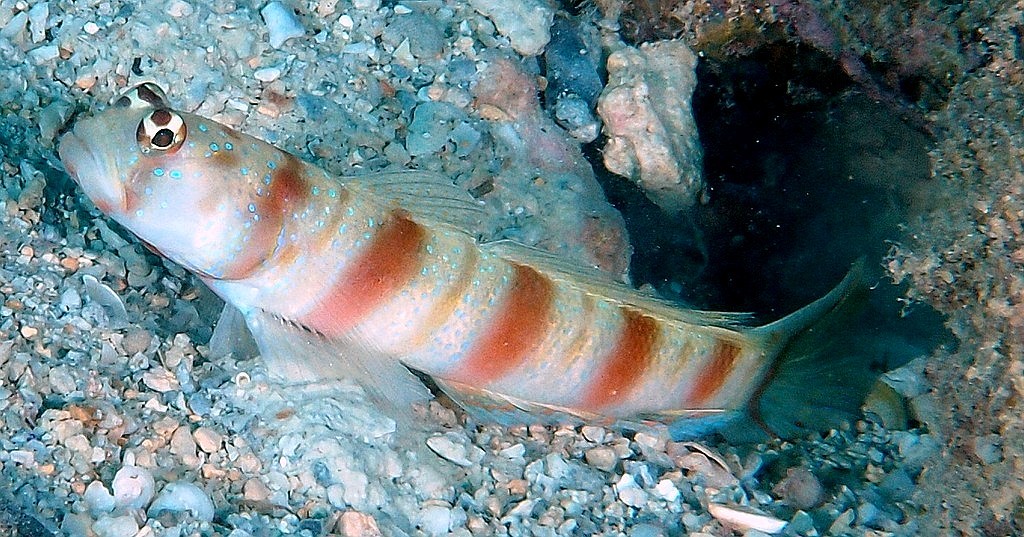AMBLYELEOTRIS OGASAWARENSIS - (YANAGISAWA, 1978)
Actinopterygii (Gigaclass) > Actinopteri (Class) > Teleostei (Subclass) > Gobiiformes (Order) > Gobioidei (Suborder) > Gobiidae (Family) > Gobiinae (Subfamily) > Amblyeleotris (Genus)
Antitropical Shrimpgoby, Ogasawara shrimp-goby, Redspotted shrimpgoby, Vyöraputokko,
Description
Dorsal spines (total): 7; Dorsal soft rays (total): 13-14; Anal spines: 1; Anal soft rays: 13 - 14. Characterized by yellowish color on back grading to white on lower half; head and body with five broad brown bars; numerous blue spots on head, in pale spaces between brown bars; caudal fin with broad white upper margin; dorsal fin with blue and yellow basal stripes; pelvic fins united by low membrane at base of fins; absence of median predorsal scales; side of nape with scales extending forward to above middle of preopercle; longitudinal scale series 80-94; greatest depth of body 5.2-5.8 in SL; lanceolate caudal fin, longer than head length. Max length : 10.0 cm. Depth range 20 - 35 m.
Etymology
Amblyeleotris: from Greek, amblys or amblus = dull (blade: not sharp), blunt, obtuse + from the Greek name of a fish, eleōtris, found in the swampy waters of the Nile (Egypt) (from the Greek, eleios = who lives in the marshes). The name Eleotris appears for the first time in Déipnosophistes, a compilation of anecdotes and quotations from ancient authors, written by a scholar and grammarian Greek, Athenaeus of Naucratis (about 170-223 AD). In 1763, the Dutch naturalist and collector Laurentius Theodorus Gronovius (1730-1777) used this name to designate a new genus of fish. The authorship of the genre escapes him because his work was rejected by the scientific community of the time. The genre should have returned to the doctor, entomologist and naturalist of Italian culture, Giovanni Antonio Scopoli (1723-1788) but the late recognition of his work made him lose the authorship of the name. Today the genus, Eleotris, is attributed to Bloch & Schneider, 1801.
Distribution
Western Pacific: Wakayama Prefecture, Chichijima, Okinawajima, and along the east coast of northern Australia. Reported from New Caledonia.
Biology
Inhabits clear coastal sand slopes, but appears to be uncommon in Indonesia. Found in sand bottoms in 20-35 m. It lives in a burrow with a snapping shrimp, often Alpheus bellulus.
Similar species
Amblyeleotris novaecaledoniae (Goren, 1981) - Reported from New Caledonia - Link to the species (here).
Antitropical Shrimpgoby, Ogasawara shrimp-goby, Redspotted shrimpgoby, Vyöraputokko,
Description
Dorsal spines (total): 7; Dorsal soft rays (total): 13-14; Anal spines: 1; Anal soft rays: 13 - 14. Characterized by yellowish color on back grading to white on lower half; head and body with five broad brown bars; numerous blue spots on head, in pale spaces between brown bars; caudal fin with broad white upper margin; dorsal fin with blue and yellow basal stripes; pelvic fins united by low membrane at base of fins; absence of median predorsal scales; side of nape with scales extending forward to above middle of preopercle; longitudinal scale series 80-94; greatest depth of body 5.2-5.8 in SL; lanceolate caudal fin, longer than head length. Max length : 10.0 cm. Depth range 20 - 35 m.
Etymology
Amblyeleotris: from Greek, amblys or amblus = dull (blade: not sharp), blunt, obtuse + from the Greek name of a fish, eleōtris, found in the swampy waters of the Nile (Egypt) (from the Greek, eleios = who lives in the marshes). The name Eleotris appears for the first time in Déipnosophistes, a compilation of anecdotes and quotations from ancient authors, written by a scholar and grammarian Greek, Athenaeus of Naucratis (about 170-223 AD). In 1763, the Dutch naturalist and collector Laurentius Theodorus Gronovius (1730-1777) used this name to designate a new genus of fish. The authorship of the genre escapes him because his work was rejected by the scientific community of the time. The genre should have returned to the doctor, entomologist and naturalist of Italian culture, Giovanni Antonio Scopoli (1723-1788) but the late recognition of his work made him lose the authorship of the name. Today the genus, Eleotris, is attributed to Bloch & Schneider, 1801.
Distribution
Western Pacific: Wakayama Prefecture, Chichijima, Okinawajima, and along the east coast of northern Australia. Reported from New Caledonia.
Biology
Inhabits clear coastal sand slopes, but appears to be uncommon in Indonesia. Found in sand bottoms in 20-35 m. It lives in a burrow with a snapping shrimp, often Alpheus bellulus.
Similar species
Amblyeleotris novaecaledoniae (Goren, 1981) - Reported from New Caledonia - Link to the species (here).
